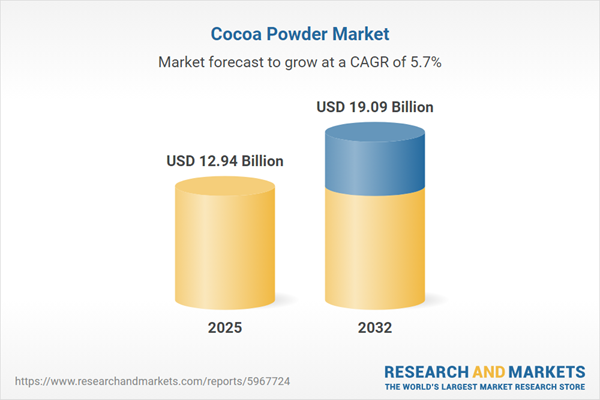Speak directly to the analyst to clarify any post sales queries you may have.
The cocoa powder market is undergoing significant transformation as senior executives seek to optimize sourcing, bolster compliance initiatives, and leverage digital tools to ensure business resilience in a dynamic global landscape.
Cocoa Powder Market Snapshot: Size and Growth Trajectory
The global cocoa powder market was valued at USD 12.24 billion in 2024 and is projected to reach USD 12.94 billion by 2025, demonstrating a compound annual growth rate (CAGR) of 5.71%. With ongoing investments in supply chain modernization and resource efficiency, the market is forecast to achieve USD 19.09 billion by 2032. Competitive pressures are prompting manufacturers and suppliers to target growth regions, scale distribution networks, and seek new business opportunities, while also reinforcing positions in established and fast-evolving markets.
Cocoa Powder Market Scope & Segmentation
- End-Use Segments: Baking, beverages, personal care, household products, and pharmaceuticals each present unique B2B requirements, driving tailored product innovation, compliance strategies, and distinct partnership models.
- Type: Dutched (alkalized) cocoa powder supports consistent product formulations for manufacturers, while natural cocoa powder aligns with clean-label initiatives, addressing diverse business client objectives.
- Packaging Formats: Cardboard, paperboard, aluminum, tin cans, and flexible plastics offer durability and protect product integrity, supporting brand reliability and logistical performance across B2B supply chains.
- Distribution Channels: Supermarkets, hypermarkets, convenience stores, specialty retail, and e-commerce facilitate agile distribution strategies to meet evolving procurement and channel demands in the B2B market.
- Application Areas: Cocoa powder is pivotal for bakery, confectionery, beverage, and dairy sectors, enabling traditional and innovative product development across these industry verticals.
- Regions Covered: North America, Latin America, Europe, Middle East & Africa, and Asia-Pacific each bring specific regulatory challenges and consumer dynamics, prompting region-tailored compliance and product adaptation.
- Key Industry Players: Barry Callebaut AG, Cargill Inc., Olam International, Archer-Daniels-Midland, Fuji Oil Holdings, Mondelēz International, Mars Inc., The Hershey Company, Blommer Chocolate Company, and Meiji Holdings Co. drive supply chain leadership and consistent sector standards.
Key Takeaways for Senior Decision-Makers
- Greater transparency throughout the supply chain strengthens ethical sourcing practices and positions organizations for sustainable, compliant growth amid evolving industry norms.
- Investments in digital transformation and automation support quality assurance and enable rapid adaptation to regulatory and market changes.
- Rising demand for clean-label and wellness-oriented cocoa products is opening channels for product differentiation, particularly among businesses targeting premium and health-driven segments.
- Expanding into diverse geographies and utilizing direct trade networks enables streamlined compliance and helps offset risks such as supply volatility and currency shifts.
- Collaboration with established leaders accelerates market entry and fosters technical innovation and scalable sustainability, reinforcing value chain resilience.
- Packaging advancements tailored for e-commerce improve B2B logistics and address increased digital procurement demand for cocoa-based ingredients.
Tariff Impact: Navigating 2025 United States Trade Policies
Shifts in U.S. tariff regulations prompt cocoa powder producers to reexamine supply chain frameworks and product formulation tactics. Strengthening domestic supplier relations and enhancing local sourcing are now integral for stability, helping to manage trade risks and maintain reliable procurement under changing policy landscapes.
Methodology & Data Sources
This assessment relies on comprehensive secondary research from industry bodies and government databases. Insights from supply chain and product development specialists further validate sector risk and opportunity analysis.
Cocoa Powder Market: Why This Report Matters
- Access actionable strategies for procurement optimization and support informed digital transformation across B2B cocoa powder operations.
- Utilize detailed segmentation and benchmarking to drive regional strategy and identify pathways for targeted business growth.
- Equip leadership teams with data-driven insights to enhance compliance and agile operations as the cocoa powder market evolves.
Conclusion
This analysis offers executives the frameworks needed to anticipate sector shifts, manage risk, and capture new business opportunities as the cocoa powder B2B market develops.
Additional Product Information:
- Purchase of this report includes 1 year online access with quarterly updates.
- This report can be updated on request. Please contact our Customer Experience team using the Ask a Question widget on our website.
Table of Contents
3. Executive Summary
4. Market Overview
7. Cumulative Impact of Artificial Intelligence 2025
Companies Mentioned
The companies profiled in this Cocoa Powder market report include:- Barry Callebaut AG
- Cargill, Incorporated
- Olam International Limited
- Archer-Daniels-Midland Company
- Fuji Oil Holdings, Inc.
- Mondelēz International, Inc.
- Mars, Incorporated
- The Hershey Company
- Blommer Chocolate Company, L.P.
- Meiji Holdings Co., Ltd.
Table Information
| Report Attribute | Details |
|---|---|
| No. of Pages | 195 |
| Published | November 2025 |
| Forecast Period | 2025 - 2032 |
| Estimated Market Value ( USD | $ 12.94 Billion |
| Forecasted Market Value ( USD | $ 19.09 Billion |
| Compound Annual Growth Rate | 5.7% |
| Regions Covered | Global |
| No. of Companies Mentioned | 11 |









